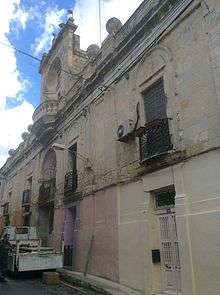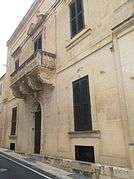Ramon Perellos y Roccaful
- Perellos redirects here; for other uses of the term, see: Perellós.
| Ramon Perellos y Roccaful | |
|---|---|
 | |
| Grand Master of the Order of Saint John | |
|
In office 7 February 1697 – 10 January 1720 | |
| Monarch |
King Charles III King Philip IV King Victor Amadeus |
| Preceded by | Adrien de Wignacourt |
| Succeeded by | Marc'Antonio Zondadari |
| Personal details | |
| Born |
1637 Aragon (modern Spain) |
| Died |
10 January 1720 Malta |
| Resting place | St. John's Co-Cathedral |
| Nationality | Spanish |
| Military service | |
| Allegiance |
|
Ramon Perellos y Roccaful, known in Spanish as Raimundo Rabasa de Perellós y Rocafull, (1637 in Valencia – 10 January 1720 in Valletta) was the 64th Prince and Grand Master of the Order of Malta from 1697 until his death. He was of Spanish origin and was 60 years old when he was elected as Grand Master.
Biography
Ramon Perellos (1637-1720)[1] was the son of the Eighth Lord of Benetússer and Fifth Baron of Dos Aguas and of María de Rocafull y Vives de Boil, his consort. He joined the Order of Malta at the age of sixteen following family tradition.[1] In 1658 he joined the board of the Master and in 1697 was elected Grand Master[2][1] and remained so until his death in 1720.[3]
Malta had organised the Consulato del Mare (Consulate of the Sea) for the first time on 1 September 1697 per initiative of Grandmaster Perellos. At the consulate it was decided that four merchants familiar enough with maritime procedures shall be appointed consuls to administer justice, on similar approach to Barcellona and Messina.[4] Perellos had established foreign relations between Malta and Russia in 1698, for the first time, exactly a century before the Order's expulsion from Malta.[5] During his grandmastership the coastal fortifications of Malta were strengthened by the construction of batteries, redoubts, and entrenchments. He also was the driving force behind the third rate squadron of the order which was eventually inaugurated in 1705.[6] In 1707 he entrusted Romano Carapecchia with the reorganization of the drainage system in Valletta.[7]
He died after 22 years as a ruler, due to illness and old age. His coat of arms was represented by three black pears against a golden background.[2] His funerary monument is found in the Co-Cathedral of St. John in Valletta and is considered to be one of the best examples of baroque art in Malta.[8]
War against corruption
Soon after his appointment, Ramon Perellos became very active in correcting cases of corruption and abuse within the Order. One such case involved the request by knights to receive graces and be nominated to the title of Gran Croce di Grazia (literally: great cross by grace). This title implied that a graced knight could replace a knight of the Great Cross upon the latter's death. This procedure was not well reputed among elder knights who spent their lifetime at the service of the Order, and resulted in many of them retiring to return to their homelands and leave their inheritances to their respective families, against the rules of the Order. The pleas of Perellos to eliminate such prejudicial recommendations were considered legitimate by Pope Innocent XII who agreed to forbid them.[2]
War against the Ottoman pirates

Perellos dedicated many of his efforts to stop the attacks at sea by Ottoman pirates, who would sail along the coasts of Spain and Italy to plunder merchant ships and enslave civilians. He ordered the knight of St. Pierre of the French Royal Naval Fleet to build a new war fleet to fight the Ottoman scourge. Meanwhile, the old galleys, together with the might of a vessel armed with 80 cannons, waged war at sea against the pirates.[2][9]
The Grand Master's new fleet was ready in port by 1706 and was headed by the same knight of St. Pierre. Three large vessels were launched that year by the names St. Vincent, St. Joseph and St. Raymond. Shortly afterwards, the fleet sailed west, where they encountered three Tunisian vessels, one of which was seized and incorporated into the fleet under the name of Santa Croce.[2][9][10]
One year later, the commanding knight Giuseppe de Langon,[11] surrounded Oran and with his sole vessel, which harbored a force of 50 cannons, traversed the entire enemy fleet despite the vain efforts of the Algerians to catch him. He was subsequently nominated Lieutenant General of the Maltese fleet.[2][9]
In 1709, the Grand Master's fleet anticipated and repelled eight Turkish vessels which attempted to infiltrate the island of Gozo. During the same year, the Grand Master sent part of his fleet to also repel a Turkish unit which was threatening Calabria. Headed by the commanding knight of Langon, the fleet managed to sink an admiral ship. In the following year the commanding knight of Langon was defeated at sea after attacking an Algerian admiral vessel. Nevertheless, the Maltese fleet emerged victorious. Between 1713 and 1715, the fleet of the Order patrolled all the coasts around the Mediterranean succeeding in various important undertakings.[2][9]
Hospital of the Order
During the rule of Grand Master Perellos, the Order was amassing great wealth. The Inquisitor Delci desired to garner greater power in Malta and attempted to take hold of the Order's hospital. This hospital was a privileged place and nobody could be admitted prior to presenting their honorary crests, however the inquisition's officers infiltrated the hospital and commenced a formal inspection. These were soon ordered to leave the premises by the commanding knight of Avernes de Bocage, who was the hospital's supervisor. This news reached Grand Master Perellos, who sent his emissary, the Great Prior Marc'Antonio Zondadari, to the Court of Rome to forward complaints about the incident.[2][12]
Siege of Venice
During the years preceding the siege of Venice, it was believed that the Ottoman Empire had preparations underway to attack Malta. This suspicion became stronger when a well-groomed man, who had approached the Order to serve as engineer and offer his wealth of knowledge about fortifications, disappeared shortly after having surveyed Malta's fortifications. Consequently, the Order began its preparations to counter any possible attack by the Ottoman army.[2]
Possibly alarmed by Malta's preparations, the Ottoman sultan directed his attention to the Republic of Venice, with which he declared war in 1716. In reply to a plea for assistance, the Grand Master Perellos lent five of his warships and a few galleys to repel the Ottoman invasion.[2]
Gallery
-

Coat of arms of Perellos at the Grandmaster's Palace in Valletta
-

Coat of arms of Perellos, the Order of St. John and the Langue of France above an inscription commemorating the construction of Dellia Battery
-
_05_ies.jpg)
Grand Master Perellos stores in Xatt il-Barriera, Valletta
-

Monument to Perellos in the Chapel of the Langue of Aragon, St. John's Co-Cathedral[1]
-

Perellos Fountain in Valletta, designed by Romano Carapecchia[2][3]
-

Casa Perellos, the hunting lodge of Grand Master Perellos
- ^ Sciberras, Keith (2004). "Roman baroque sculpture for the Knights of Malta". Fondazzjoni Patrimonju Malti. p. 119. ISBN 99932-10-29-3. ISBN 978-99932-10-29-0.
- ^ De Lucca, Denis (1999). Carapecchia: Master of Baroque Architecture in Early Eighteenth Century Malta. Midsea Books. p. 140. ISBN 9990993009.
- ^ UOM. p. 15.
References
- 1 2 3 Zabala, Fernanda (2003). 125 valencianos en la historia. Malta: Carena Editors, S.L. p. 258. ISBN 84-87398-64-2.
- 1 2 3 4 5 6 7 8 9 10 Furse, Paul G. F. (1864). Il Medagliere gerosolimitano ossia Raccolta delle medaglie e monete coniate dai Gran Maestri dell'Ordine Gerosolimitano in Rodi ed in Malta. Malta: Albion Press. pp. 53–55.
- ↑ Ceresa, Massimo (1986). DAL POZZO, Bartolomeo. Dizzionario Biografico. Retrieved 2 July 2016.
- ↑ http://melitensiawth.com/incoming/Index/Melita%20Historica/MH.02(1956-59)/MH.2(1958)3/orig04.pdf p. 166.
- ↑ Denaro, Victor F. (1961). "More houses in Valletta" (PDF). Melita Historica. 3 (2): 5–6. Archived from the original (PDF) on 23 March 2016. p. 9.
- ↑ Castillo, DennisAngelo (2006). The Maltese cross: a strategic history of Malta. 229. Malta: Greenwood Publishing Group. pp. 87–92.
- ↑ http://www.timesofmalta.com/articles/view/20150621/life-features/origin-and-development-of-vallettas-mandraggio.573635
- ↑ Aldo E. Azzopardi, Malta e le sue isole, Sesto Fiorentino, Centro Stampa Editoriale, ISBN 88-7280-615-1. p. 118
- 1 2 3 4 de Vertot d'Aubeuf, Rene Aubert (1726). Histoire des Chevaliers Hospitaliers de St. Jean de Jerusalem, appellez depuis les Chevaliers de Rhodes, et aujourd'hui les Chevaliers de Malte. 2. Lyon: Rollin. pp. 196–198.
- ↑ Whitworth, Porter (1871). Malta and its Knights. London: Pardon and Son. pp. 196–198.
- ↑ "The rise and fall of the Order's fleet". Times of Malta. 27 April 2016.
- ↑ Sutherland, Alexander (1830). The Achievements of the Knights of Malta. 2. Edinburgh: Constable's Miscellany of Original and Selected Publications. pp. 277–278.
External links
| Preceded by Adrien de Wignacourt |
Grand Master of the Knights Hospitaller 1697–1720 |
Succeeded by Marc'Antonio Zondadari |